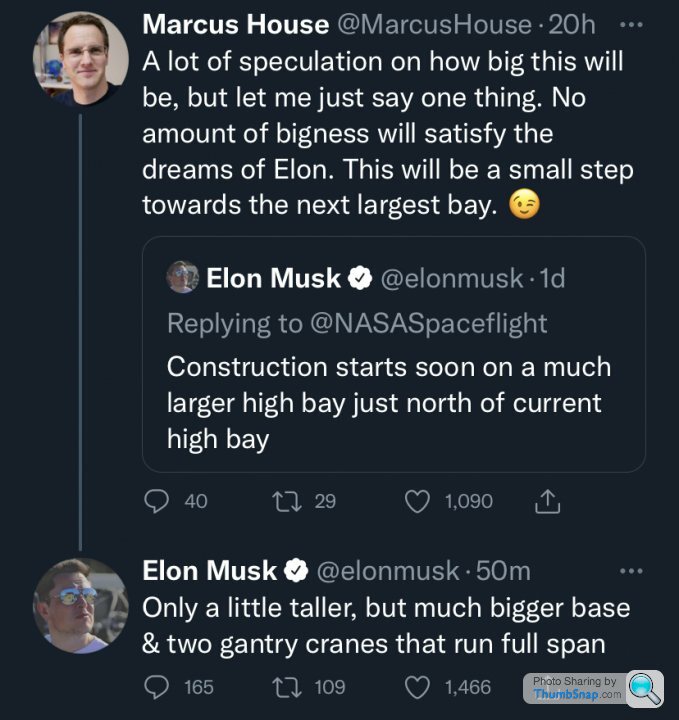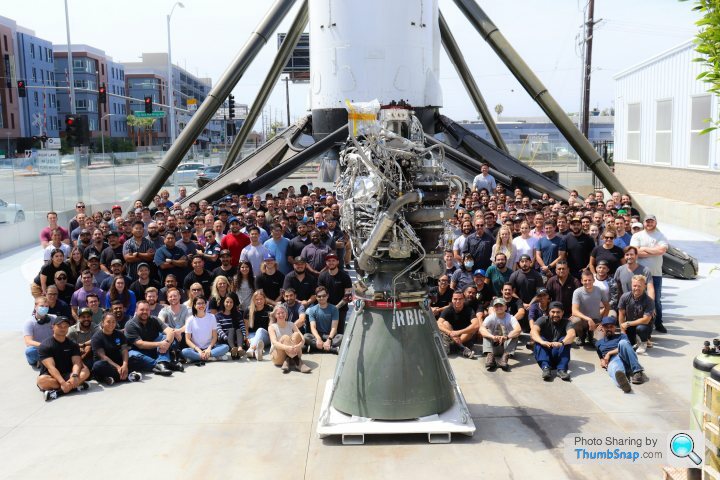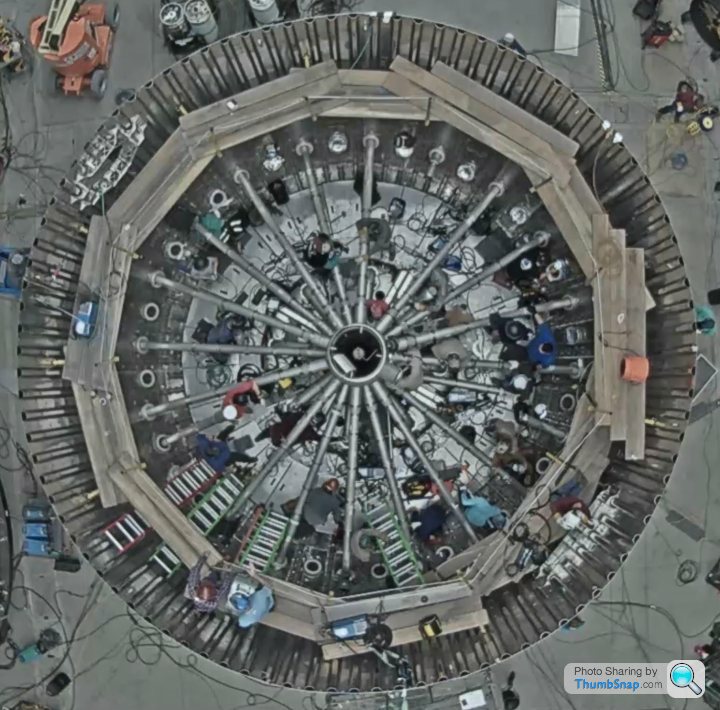SpaceX (Vol. 2)
Discussion
rxe said:
CraigyMc said:
My sums may be wrong, but I think a fully fuelled starship booster exploding would be in the same rough class as an A bomb going off.
The brisance would be much lower (the resulting shockwave would not be as destructive) but the overall energy release is in the right range to be comparable with a Hiroshima-sized A bomb.
Well it is 1200 tonnes of propellant, so it will be in the kiloton range .... I know kilotons are measured in TNT, but it will be in the same ballpark. I think the impact would depend on exactly how it happened, but a well mixed vapour cloud explosion can be a really big bang. I think Flixborough involved 15 tonnes of cyclohexane, but was equivalent to a 0.25 kiloton weapon.The brisance would be much lower (the resulting shockwave would not be as destructive) but the overall energy release is in the right range to be comparable with a Hiroshima-sized A bomb.
Worst case of the thing breaking up as it launches and dumping the contents of the fuel tanks over 100 meters could easily be in the 10 KT range.

The rationale and full calculations are buried in the Space Shuttle Range Safety Command Destruct System Analysis and Verification second link below (I think), but the following reading might prove useful if you're worried about kiloton-range effects and can't sleep....
PHASE I - DESTRUCT SYSTEM ANALYSIS AND VERIFICATION
PHASE II - ORDNANCE OPTIONS FOR A SPACE SHUTTLE RANGE SAFETY COMMAND DESTRUCT SYSTEM
PHASE III -BREAKUP OF SPACE SHUTTLE CLUSTER VIA RANGE SAFETY COMMAND DESTRUCT SYSTEM
Edited: 125 tonnes of TNT for a 3400 tonne Super Heavy.
Edited by eharding on Friday 23 July 16:15
NASA has awarded SpaceX the contract to launch the Europa Clipper mission to Jupiter on a Falcon Heavy in 2024.
It was originally going to launch on the SLS, but that was pulled back at the start of the year. They were worried about the shaking from two big solid boosters and they also didn’t think Boeing could build a rocket in time, along with all their Moon commitments.
https://en.wikipedia.org/wiki/Europa_Clipper
It was originally going to launch on the SLS, but that was pulled back at the start of the year. They were worried about the shaking from two big solid boosters and they also didn’t think Boeing could build a rocket in time, along with all their Moon commitments.
https://en.wikipedia.org/wiki/Europa_Clipper
Edited by Beati Dogu on Friday 23 July 22:53
xeny said:
Wondering now if they want taller for bigger boosters, or wider for making more boosters at once?
Ars BTW is saying SLS would be more than $2 billion for the Clipper launch.
If Falcon Heavy can launch space probes at a fraction of the cost, does that mean that the scientific community will have greater project/launch opportunities?Ars BTW is saying SLS would be more than $2 billion for the Clipper launch.
Yes, to a point. However launch costs are usually just a fraction of the overall cost. Most big communications satellites will cost hundreds of millions of dollars each. The big military and spy sats are likely a billion or more a pop. NASA probes and landers are usually even more. The James Webb Space Telescope, is way over $10 billion so far and still hasn't launched yet.
The trick is to be cheaper and reliable, which SpaceX are managing so far.
The trick is to be cheaper and reliable, which SpaceX are managing so far.
Beati Dogu said:
Yes, to a point. However launch costs are usually just a fraction of the overall cost. Most big communications satellites will cost hundreds of millions of dollars each. The big military and spy sats are likely a billion or more a pop. NASA probes and landers are usually even more. The James Webb Space Telescope, is way over $10 billion so far and still hasn't launched yet.
The trick is to be cheaper and reliable, which SpaceX are managing so far.
Lower launch costs can also reduce the cost of the payload. High payload capacity can reduce the need to use exotic materials to save weight. High launch on demand cadence can avoid the need for on-orbit replacement satellites and also less demanding reliability requirements. It's also possible to replace a few large satellites with lots of smaller satellites that collectively provide the same or superior capability) e.g. Starlink).The trick is to be cheaper and reliable, which SpaceX are managing so far.
Naturally some projects will still use exotic materials so that they can use the extra weight for even more instruments (your long term deep space probes and rovers will likely remain very demanding) but particularly with low earth orbit satellites we're already seeing lower launch costs changing the design and operation of the payloads they carry.
Beati Dogu said:
"Construction starts soon on a much larger high bay just north of current high bay" - Elon
The "really high bay" perhaps.
It'll be a wide high bay, for Starship rather than Booster construction.The "really high bay" perhaps.
There will only be a few boosters, but lots of Starships (Musk has stated i.r.o. a 1000)
So if he wants a 1000 Starships in 10 years, that's 1 every 3-4 days.
MiniMan64 said:
xeny said:
Wondering now if they want taller for bigger boosters, or wider for making more boosters at once?
Ars BTW is saying SLS would be more than $2 billion for the Clipper launch.
At what point does Starship make SLS obsolete?Ars BTW is saying SLS would be more than $2 billion for the Clipper launch.
xeny said:
annodomini2 said:
When Congress chooses to stop funding it
 - Think of SLS not as a launcher so much as a way to distribute federal money.
- Think of SLS not as a launcher so much as a way to distribute federal money.All rocketry comes under ITAR.
They want to keep the knowledge and skills in the US, it has the added benefit for the politicians that it helps buy votes in their respective constituencies.
Beati Dogu said:
Yes, to a point. However launch costs are usually just a fraction of the overall cost. Most big communications satellites will cost hundreds of millions of dollars each. The big military and spy sats are likely a billion or more a pop. NASA probes and landers are usually even more. The James Webb Space Telescope, is way over $10 billion so far and still hasn't launched yet.
The trick is to be cheaper and reliable, which SpaceX are managing so far.
Worth also noting that if your launch costs $1000 million you want to make really sure the satellite works and you want it to last a long time, so you spend plenty on testing over and over again as well as ensuring super reliability and building in redundant components.The trick is to be cheaper and reliable, which SpaceX are managing so far.
If your launch costs $100 million, you can approach reliability and redundancy by just launching two or three duplicate satellites each of which can therefore cost significantly less to produce (cheaper components and building the same thing more than once you get better at it). You can approach longevity by just booking another launch for a couple of years' time.
Quantity has a quality all of its own, etc.
https://www.gao.gov/press-release/statement-blue-o...
They've rejected the objection from Blue Origin and Dynetics on the lander selection.
So I guess it will probably go to court.
They've rejected the objection from Blue Origin and Dynetics on the lander selection.
So I guess it will probably go to court.
Gassing Station | Science! | Top of Page | What's New | My Stuff





